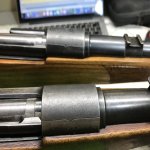I watched a fellow do this once in Austria.
This is fairly important. You need to have a regular surface to start with. If your rifle's receiver has been aggressively ground, in an uneven manner, it will be next to impossible to hide.
The rifle I watched having its receiver peened, had the markings removed tastefully with a surface grinder. You could accomplish something similar with a belt sander.
In this case the engraver cut out a frame, around the area he was going to peen.
Next, he took a very coarse piece of emery cloth and with a small hammer used it to matte the surface of the area he intended to peen. I was a bit curious about that and he told me it was to make it easier to peen the surface.
He didn't use a punch. He had a special hammer (appx 3oz) with one end flat and the other tapered to a point, which as trevj mention was ground round. NOT A LARGE TIP. Almost like the tip had been slightly dulled after being ground to a fine point.
The receiver was being held in a cradle, which could be adjusted to get at the surface to be peened. There was good light, with a magnifying lens use to see the area.
The fellow, with very even and carefully practiced strokes proceeded to tap the pointed end onto the surface he wanted to leave a brinneled appearance. Took him about a half hour for each receiver.
This would take me half the day.
If your receiver has been taken down with a surface grinder or belt sander, place coarse emery cloth, grit side down over area you want to cover. Mask it off with tape first, to keep it neat. Use a small 3 oz flat face hammer to tap the grit side of the emery cloth against the receiver. Then apply cold blue. It actually gives quite a pleasant appearance.









































































